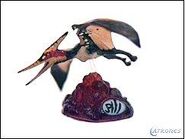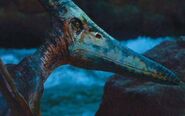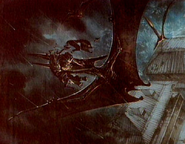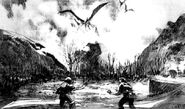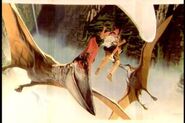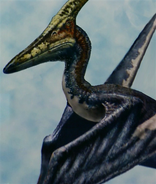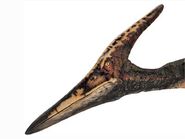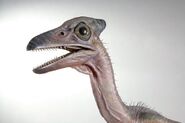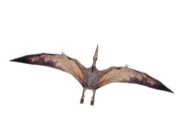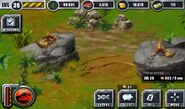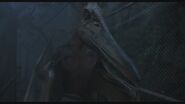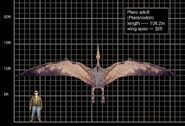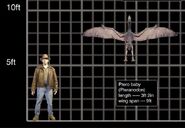- "Oh my God. It's a birdcage."
- —Alan Grant(src)
This information was shown on the (removed) Jurassic Park Institute site.
Pteranodon is a massive flying reptile. When it spread its wings, it could reach from the front to the back of a school bus. Just imagine something that big flying around. It did not have feathers, but rather had a basal type of integument along the same lineage that feathers evolved upon called pycnofibers. Pycnofibers were very hair-like in appearance and, like hair, were made of keratin.
Members of the Pterosaur order lived through much of the Mesozoic, some species of Pterosaurs with wingspans close to 11 m (36 feet). Pteranodon males had a wing span of 5 metres (18 feet), while females had a wing span of 3 meters (12 feet). Making it one of the largest Pterosaurs found.
Pteranodon, as you can tell by the translation of its name, had no teeth, something portrayed (it having teeth) in the movie. It probably used the long crest on the back of its head to help it steer while flying. The movement is still some debate about whether these reptiles could actually fly or if they were primarily gliders, but the consensus seems to be that they could take off with little or no wind.
Their diet was fish and scavenged remains of dead marine animals. Quite a few Pteranodon skeletons have been found in Kansas in the central part of the U.S. This would have been the shore of a shallow sea when these creatures were alive, supporting the theory that they were fish eaters.[1]
| Wikipedia has a more detailed and comprehensive article on Pteranodon |
Portrayal
Accuracy
The Pteranodons in Jurassic Park III are depicted correctly with regards to their size (paleontologists claim that the largest species had a wingspan up to 10 m (33ft) wide, being the size of a small aircraft), as well as their quadrupedal gait. They are, however, shown incorrectly to have teeth, stemming from an unknown mutation. In The Lost World they are portrayed as toothless. Paleontologists believe that Pteranodons could not lift prey with their feet, simply because their feet were not designed to grasp; instead, they caught most of their prey with their large beaks. They also lack the fur-like pycnofiberous integument that all true Pterosaurs had.
The number of eggs or young that Pteranodons could have in one single brood is unknown; however, the film correctly portrays Pterosaurs as being able to fly from a very early age, like real Pterosaurs. All Pteranodons in Jurassic Park III are shown to have long crests of about the same size, when in real life, only Pteranodon males would have had large crests, with females having smaller ones. Jurassic Park, Pteranodon suffer from the same level of accuracy that plagues most pop cultural depictions of Pterosaurs: it is basically "stuck in the 70's", being depicted as a naked, leathery creature instead of the warm-blooded, almost bird-like animals that real Pterosaurs were, but with weather the case Pteranodon was also depicted with neckbrace of fur. In the second film, they are depicted as bipedal and with bird-like necks, while real Pterosaurs were quadrupedal and had rigid, thick necks like those of mammals. The third film fixes these errors, though it depicts them with grasping, bird-like feet and teeth.
Vocalizations
Pteranodons were given a wide array of calls and vocalizations in Jurassic Park III, as well as an eerie, bird-like scream at the end of The Lost World which was created using a generic screech from Gary Rydstom taking out toothfloss from his teeth. The film creators used large bird sounds (including giant petrels) for the Pteranodons. Voice actor Frank Welker also lent his voice for some of the vocals. In many of the Jurassic Park games the Pteranodon's calls vary and are not based on their sounds used in the films in most Jurassic Park III games, the calls are basically comprised of sounds from a Red-tailed Hawk. While in Jurassic Park: The Game the Pteranodon's calls are comprised from sounds of vultures.
Interaction with humans
In Jurassic Park III and Jurassic Park Adventures: Flyers, Pteranodons are shown to be extremely aggressive and to attack any human that enters their territory (the Canyon Aviary), just as the Cearadactylus did in the original Jurassic Park novel. However, while Cearadactylus seemed to attack humans out of territoriality, the Pteranodons in Jurassic Park III obviously see humans as suitable prey and attack them to eat them. This is implied by the presence of human bones in the Pteranodon nest and the fact that the adult Pteranodon threw Eric Kirby to the nest in order for its young to attack him. Later in the film, three adult Pteranodons are shown flying near several helicopters, but they ignore them completely (although the original script had the Pterosaurs to attack the helicopter). Other than the human remains of the Pteranodon nest, no fatal victims of Pteranodon are known in Jurassic Park III. They did, however, manage to almost kill Billy Brennan (who probably survived only because the river current dragged him out of the Canyon Aviary, where the Pteranodons could not follow him). In the script they do kill Billy. It is unknown why the Jurassic Park crew would choose to let the Pteranodons roam free since they can fly off of Isla Sorna. However, it is likely they were confident that Pteranodon would not abandon Isla Sorna since it is the only suitable land for them to live on.
Jurassic Park novels

Novel with Pteranodon
Pteranodons were not present in the first and second Jurassic Park novels. Instead the first novel portrayed only one species of Pterosaur, the Cearadactylus, which is somewhat smaller, being featured in the park's Aviary.
A group of Pteranodons is shown at the back of Barnes & Noble's Novel bundle
, some of which have tails, others without.
Film canon

Pteranodons in Jurassic Park: The Game.
In the film canon however, Pteranodon was ultimately chosen instead of Cearadactylus, probably because of its larger size, more spectacular/impressive appearance and massive popularity with audiences.
Steven Spielberg did not want to have the Cearadactylus in the first Jurassic Park film, as he previously felt that the aviary scene exactly described in the novel would have been too expensive and complicated to recreate, resulting in this scene being among the first to be automatically scrapped from the filming schedule. Certain scenes when Grant and the kids travel down the river were filmed, but also quickly scrapped.
Jurassic Park: The Game
Pteranodon also appears in Jurassic Park: The Game. A small flock of them is briefly seen flying alongside a cliff at the start of scenario Flyover. Later, in the scenario Chopper Down! one attacks the mercenary's chopper.
It is surprising that they are seen having free run of the island. This flock probably escaped from the Isla Nublar Aviary after the power went down. However, the fact that they are based off their much later appearance in Jurassic Park III.
While they're based off their JP III appearance, their sounds were different. While the JPIII Pteranodons made a range of vocalizations, from screams to hisses to soft clucks, the Pteranodons in JP: The Game made only a raspy squawking sound, similar to that of a vulture which might make them almost, but not fully grown yet.
The Lost World: Jurassic Park
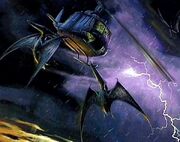
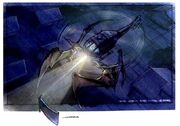
Later in The Lost World: Jurassic Park, Spielberg wanted to show an action sequence called Air Attack which has a team of gatherers running away from a pack of Velociraptors and leaping off a cliff with hang gliders from their backpacks. However, while they are safely flying in the air they are attacked by Pteranodons or Geosternbergia. Once again, the idea was ultimately abandoned (although conceptual art for both animals as well as maquettes for Pteranodons exist for that film). Another action sequence was developed but was also cut, where Pteranodons were attacking the rescue chopper. The second film does depict the Pteranodon in its final version though at the very end of the film, several are shown flying above the Stegosaurus herd and in the sky while one of them is shown briefly up close.

Pteranodon as seen in The Lost World: Jurassic Park
This Pteranodon is shown to be of a very lean body build with an S shaped neck and a slender, hook ended beak. It is also shown to perch on a tree the same way a bird would, which would be very impossible for the real live animal, as Pteranodon never have grasping feet and was only a quadruped when it landed. The Pteranodons in The Lost World were based on a species called Pteranodon longiceps. Originally Steven Spielberg wanted to use Geosternbergia, but changed the animal at the last minute, probably for the more straight and elegant crest of the P. longiceps. The concept art for Geosternbergia can still be seen.
Jurassic Park III
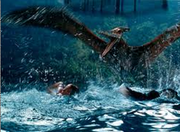
In Jurassic Park III, they do not appear but are instead replaced by mutant untrue Pteranodon quarantined in the Isla Sorna Aviary. Director Joe Johnston had the species re-designed for this film. They were shown as being larger, more robust and different colored than the ones shown at the end of The

Pteranodon silhouette. (Jurassic Park III)
Lost World. They also lack a hooked bill, but have rows of dinosaur-like teeth on their mouths (something real-life Pteranodons never have).
In Jurassic Park III the main characters enter unknowingly a massive bird cage in a river canyon containing four mutant adult female Pteranodons and a nest filled with precocious, voracious hatchlings. 13-year-old Eric Kirby is snatched by one of them and thrown to the nest to serve as food for the young, but Billy Brennan manages to save him. He however, ends up being attacked himself, and is brutally mauled and severely injured by them. Later when they escape the bird cage, the Kirbys accidentally leave the cage's door open, the Pteranodons might have escaped the aviary through this door. They are briefly seen at the end of the film, heading for "new nesting grounds". It is unknown whether the adults abandoned their chicks or were simply exploring the island's surroundings, perhaps planning for a future, actual escape.

The Male Pteranodon of JPIII
Jurassic World
Pteranodon and Dimorphodon reside in the Aviary of Jurassic World according to the park's brochure.
Jurassic Park Adventures

In the novel Flyers, the flock of 7 Pteranodons that is seen at the end of Jurassic Park III has reached Universal Studios in Florida and starts to terrorize the tourists. They drive all tourists into the central Lagoon to eat them after sunset.
All creatures have a name:
- Elder: the patriarch of the group
- Flood: Elder's daughter. Her markings were blue like the waves and gray like the rocky shore.
- Fire: Flood's mate, a strong and powerful creature. With his crimson markings he looks like the fiery dawn.
- Goldie: most troublesome child of Fire and Flood. Has a bright golden tinge on his wings.
- Lightning: another young. His wings bare two silver streaks like lightning.
- Spike: young.
- Trip: young.
The Pteranodons have a much greater body mass them their prehistoric counterparts, weighing 500-600 lbs. instead of 45 lbs. They're also much more intelligent. It is suggested that InGen probably wanted the Pteranodons to be able to do tricks in shows and therefore enhanced their intelligence.
Pteranodon were also mentioned in the first book where Eric witnesses a Tyrannosaurus killing one.
Jurassic Park inspired games
- Geosternbergia appears as a wildlife ambience in the video game The Lost World: Jurassic Park; especially, on the Sulphur Fields level.
- It is encountered in all areas of Jurassic Park (arcade game).

The lost World: Jurassic Park (arcade game)
- It also appears in the Site B lab in The Lost World: Jurassic Park (arcade game). While you are on a zipline trying to reach the lab, Geosternbergias attack you and you need to shoot them.
- Pteranodon appears in Jurassic Park: Trespasser on the mural in the operations center
- It is encountered in Chapter 3 of Jurassic Park III (arcade game).
- Pteranodon is one animal you need to get DNA from in Jurassic Park 3 Danger Zone!
- Pteranodon is an enemy in Jurassic Park III: Island Attack.
- Pteranodon is an enemy in Jurassic Park III: The DNA Factor.
- It would appear in the planned game Jurassic Park: Survival.
- Pteranodon can be created from paleo-DNA in the game Jurassic Park III: Park Builder. A Giant Pteranodon can also be created, and it may be simply a male Pteranodon, as it looks similar to what the males were planned to look like.

Pteranodon from Jurassic Park III: Park Builder.

Giant Pteranodon from Jurassic Park III: Park Builder.
- It is one of the Carnivores that is featured in the game Jurassic Park III: Dino Defender
- In Dinosaur Battles, a few Pteranodons appeared, but they are unplayable.
- Pteranodon is one of the available creatures in the IOS application, Jurassic Park: Builder.
Jurassic Park: Explorer
Pteranodon is one is the creatures that can be captured in the game Jurassic Park: Explorer. When a Pteranodon is captured this video will be shown. It also appears in a short clip flying above a river.
Comic books

Pteranodon from Topps Jurassic Park comics. (Image courtesy of Jurassic Park Legacy)
Two Pteranodons attack the plane of Lex Murphy in Jurassic Park: Redemption I as she is flying over Costa Rica. Two armed aircraft try to drive the creatures away.
The Pteranodons appeared in Jurassic Park: The Devils in the Desert, killing people, and at one point, a horse. The Pteranodons were all killed, with the last one killed in a zoo by a polar bear.
Jurassic Park Toys
Pteranodon figures have appeared in many toy lines. The most classic is the blue/gray figure from the Kenner Series 1. This figure was so well known that it appeared in Toy Story. The figure was re-painted for later reappearances in Jurassic Park: Dinosaurs and The Lost World Series 1. Another figure was released for the Jurassic Park III toyline.
Other figures have appeared in:
- Die-Cast: Jurassic Park
- The Lost World Series 1
- Jurassic Park III (Hasbro)
- Jurassic Park III (Kaiyodo) (prototype only)
- CamoXtreme
- Jurassic Park: Dinosaurs
- Jurassic Park: Dinosaurs 2
- Jurassic Park: Dinosaurs 3
Gallery
Exhibitions
- An animatronic Pterosaur is shown in the T. rex encounter attraction of the Jurassic Park Institute Tour.
Trivia
- It has appeared in the background in the film adaption of The Lost World: Jurassic Park, even though that it was said they first appeared in Jurassic Park III . They may have been they were talking about in their first major role.
Sources
Picture in infobox was made by the Jurassic Park Institute.
Notes
| Compsognathus • Gallimimus • Mamenchisaurus • Pachycephalosaurus • Parasaurolophus • Pteranodon • Stegosaurus • Triceratops • Tyrannosaurus rex • Velociraptor |
| Ankylosaurus • Brachiosaurus • Ceratosaurus • Compsognathus • Corythosaurus • Parasaurolophus • Pteranodon • Spinosaurus • Stegosaurus • Triceratops • Tyrannosaurus rex • Velociraptor |
| Ankylosaurus • Apatosaurus • Dimorphodon • Gallimimus • Indominus rex • Mosasaurus • Pachycephalosaurus • Parasaurolophus • Pteranodon • Stegosaurus • Triceratops • Tyrannosaurus rex • Velociraptor |







